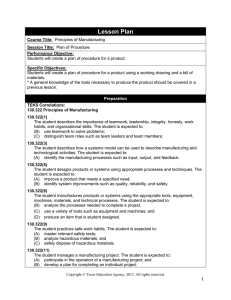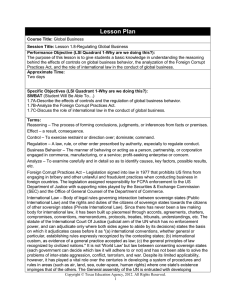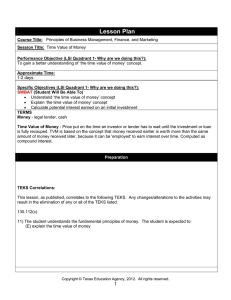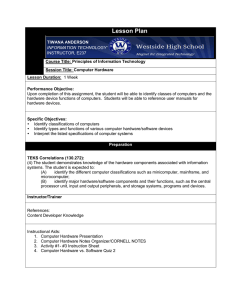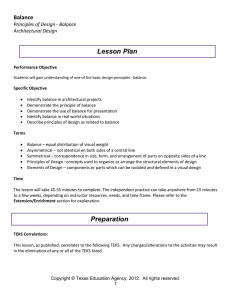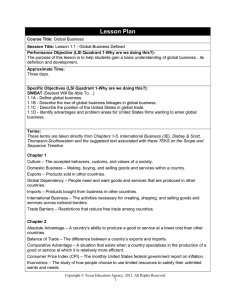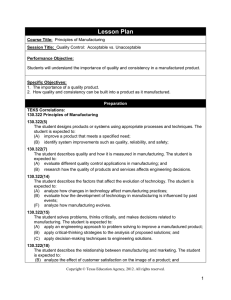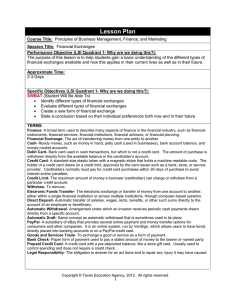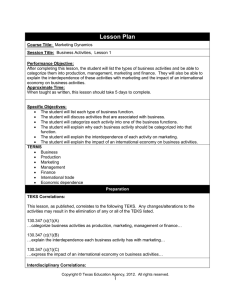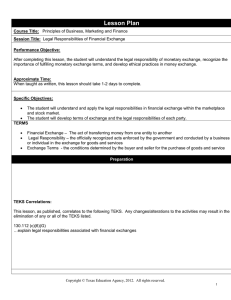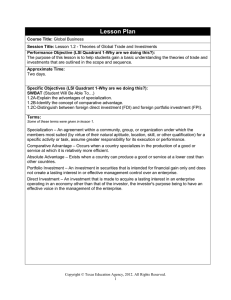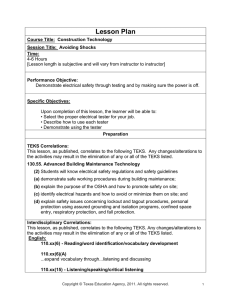Lesson Plan
advertisement
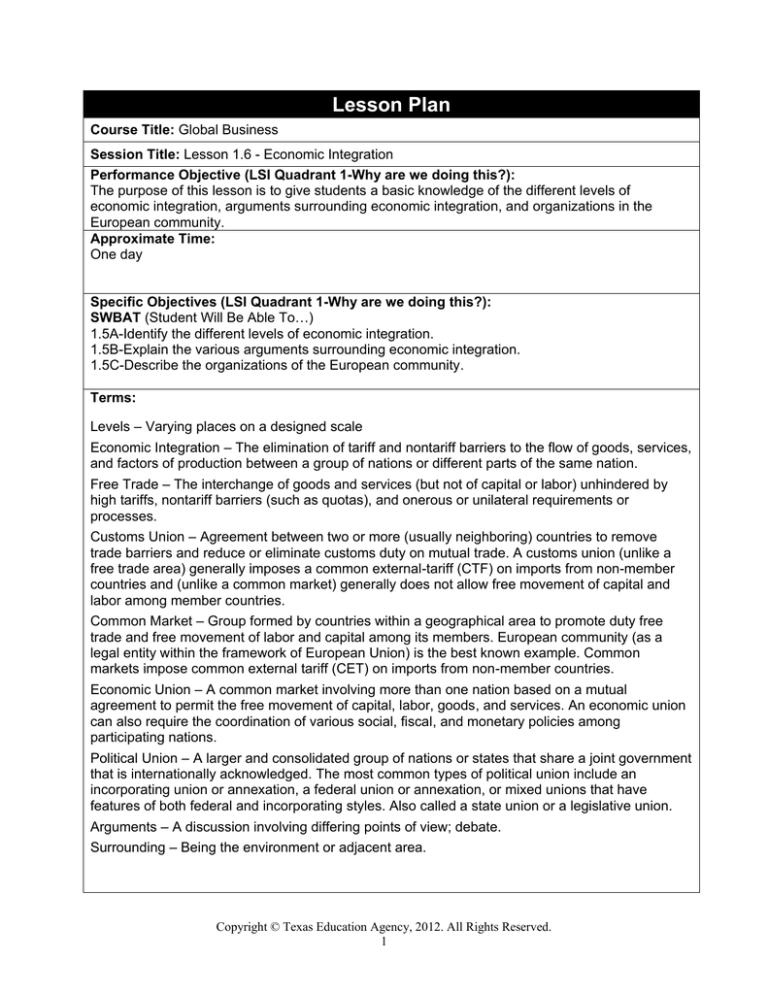
Lesson Plan Course Title: Global Business Session Title: Lesson 1.6 - Economic Integration Performance Objective (LSI Quadrant 1-Why are we doing this?): The purpose of this lesson is to give students a basic knowledge of the different levels of economic integration, arguments surrounding economic integration, and organizations in the European community. Approximate Time: One day Specific Objectives (LSI Quadrant 1-Why are we doing this?): SWBAT (Student Will Be Able To…) 1.5A-Identify the different levels of economic integration. 1.5B-Explain the various arguments surrounding economic integration. 1.5C-Describe the organizations of the European community. Terms: Levels – Varying places on a designed scale Economic Integration – The elimination of tariff and nontariff barriers to the flow of goods, services, and factors of production between a group of nations or different parts of the same nation. Free Trade – The interchange of goods and services (but not of capital or labor) unhindered by high tariffs, nontariff barriers (such as quotas), and onerous or unilateral requirements or processes. Customs Union – Agreement between two or more (usually neighboring) countries to remove trade barriers and reduce or eliminate customs duty on mutual trade. A customs union (unlike a free trade area) generally imposes a common external-tariff (CTF) on imports from non-member countries and (unlike a common market) generally does not allow free movement of capital and labor among member countries. Common Market – Group formed by countries within a geographical area to promote duty free trade and free movement of labor and capital among its members. European community (as a legal entity within the framework of European Union) is the best known example. Common markets impose common external tariff (CET) on imports from non-member countries. Economic Union – A common market involving more than one nation based on a mutual agreement to permit the free movement of capital, labor, goods, and services. An economic union can also require the coordination of various social, fiscal, and monetary policies among participating nations. Political Union – A larger and consolidated group of nations or states that share a joint government that is internationally acknowledged. The most common types of political union include an incorporating union or annexation, a federal union or annexation, or mixed unions that have features of both federal and incorporating styles. Also called a state union or a legislative union. Arguments – A discussion involving differing points of view; debate. Surrounding – Being the environment or adjacent area. Copyright © Texas Education Agency, 2012. All Rights Reserved. 1 Preparation TEKS Correlations: This lesson, as published, correlates to the following TEKS. Any changes/alterations to the activities may result in the elimination of any or all of the TEKS listed. 1.5 The student demonstrates various levels of economic integration among foreign countries. 1.5A-Identify the different levels of economic integration. 1.5B-Explain the various arguments surrounding economic integration. 1.5C-Describe the organizations of the European community. Interdisciplinary Correlations: English-English 1 110.31(b)(1). Reading/Vocabulary Development. Students understand new vocabulary and use it when reading and writing. 110.31(b)(11). Reading/Comprehension of informational text/procedural texts. Students understand how to glean and use information in procedural texts and documents. Occupational Correlation (O*Net – www.onetonline.org/) Job Title: Environmental Economists O*Net Number: 19-3011.01 Reported Job Titles: This title represents an occupation for which data collection is currently underway. Tasks: Assess the costs and benefits of various activities, policies, or regulations that affect the environment or natural resource stocks, collect and analyze data to compare the environmental implications of economic policy or practice alternatives, and develop programs or policy recommendations to promote sustainability and sustainable development. Soft Skills: None reported at this time. Teacher Preparation: The teacher will review the terms in the outline, presentation slides, and any provided materials to become familiar with the lesson. Teacher should locate and evaluate various resources and websites before the lesson. Teacher will have assignments and website information ready to distribute to students. Copyright © Texas Education Agency, 2012. All Rights Reserved. 2 References: www.dictionary.com www.businessdictionary.com textbook http://people.hofstra.edu/geotrans/eng/ch5en/conc5en/economicintegration.html http://idealab.talkingpointsmemo.com/2012/03/president-obama-calls-on-china-to-lift-rare-earthtrade-restrictions.php http://europa.eu Instructional Aids: Lesson 1.6 Presentation-Economic Integration Access to Internet Access to businessdictionary.com and dictionary.com Materials Needed: Lesson 1.6 Presentation-Economic Integration Lesson 1.6-Formal Assessment Lesson 1.6-Formal Assessment Key Equipment/Software Needed: Projection unit Instructor computer Internet access Electronic system for taking notes Learner Preparation: Purpose of Assignment and Need to Know Terms - Snapshots of slides below. Introduction Introduction (LSI Quadrant I-Why are we doing this lesson?): ASK: Do you know all the levels of economic integration? ASK: Did you know there are levels? ASK: Do you know which type of economic integration the US uses? ASK: Did you know some people think what we do as a country, when it comes to importing and exporting goods, is wrong and some think it’s right? ASK: Do you think our country should continue to practice free trade or should we think about Copyright © Texas Education Agency, 2012. All Rights Reserved. 3 doing something different? ASK: Do you know which level of economic integration is most used? SAY: We’re going to learn today about the different levels of integration, some arguments surrounding it, and take a look at the way Europe handles its economic system. Outline Outline (LSI Quadrant II-What are we doing in this lesson?): Instructors can use the presentation program/software, slides, handouts, and notes pages in conjunction with the following outline. MI Outline I. Introduction A. Lesson Objectives B. Need to Know Terms . (See provided presentation for details.) Notes to Instructor There is no provided discovery activity for this lesson. II. Guided Instruction A. Instruction-Levels of Economic Integration B. Levels Activity Slides 4 and 5 in presentation. III. Guided Instruction A. Instruction-Arguments B. Arguments Activity Slides 6 and 7 in presentation. IV. Guided Instruction A. The European Community Slide 8 in the presentation. Copyright © Texas Education Agency, 2012. All Rights Reserved. 4 Verbal Linguistic V. Review Slide 10 in the presentation. VI. Formal Assessment Use provided assessment documents. Logical Mathematical Visual Spatial Musical Rhythmic Bodily Kinesthetic Intrapersonal Interpersonal Naturalist Application Introduction-(LSI Quadrant III-How are we going to do this?): Purpose of Assignment and Need to Know - Snapshots copied and pasted below: Guided Instruction (LSI Quadrant III-How are we going to do this?): Instruction - Slide snapshot copied and pasted below: Copyright © Texas Education Agency, 2012. All Rights Reserved. 5 Existentialist Informal Assessment (LSI Quadrant III-How are we going to do this?): Check one or all of the following: • Need to Know terms • Levels of Economic Integration Activity • Arguments Activity • Class discussion Summary Review (LSI Quadrants I-Why are we doing this lesson? and IV-Extending the lesson): Purpose of Assignment, Review, and Extensions - Slide snapshots copied and pasted below: Evaluation Informal Assessment (LSI Quadrant III): Check one or all of the following: • Need to Know Terms • Case Study Research items • Notes taken during class lecture/discussion Extension Copyright © Texas Education Agency, 2012. All Rights Reserved. 6 Extension/Enrichment (LSI Quadrant IV-Extending the lesson): Extensions - Slide copied and pasted below: Copyright © Texas Education Agency, 2012. All Rights Reserved. 7 Formal Assessment (LSI Quadrant III-How are we doing this?) Lesson 1.6 Formal Assessment (provided) Lesson 1.5 Formal Assessment Key (provided) Copyright © Texas Education Agency, 2012. All Rights Reserved. 8 Levels of Economic Integration Chart recreated from chart found at http://people.hofstra.edu/geotrans/eng/ch5en/conc5en/economicintegration.html Political Union Economic Union Level of Integration Common Government Common Currency, harmonized tax rates, common monetary and fiscal policy. Common Market Factors of production move freely between members. Customs Union Common external tariffs. Free Trade Free trade between members. Complexity Lesson 6 ‐ Economic Integration Formal Assessment Objective: To determine your level of understanding of the different levels of economic integration, arguments surrounding economic integration, and organizations in the European community. Please answer the following questions (be specific and detailed). 1. The USA uses the Free Trade System. Europe uses the Common Market/Economic Union System. Which is better and why? 2. Choose an argument (from the five in the presentation) and restate it in your own words. 3. Taken from the European Community web page and in this presentation (slide 8), ‘It (European Community) was created in the aftermath of the Second World War. The first steps were to foster economic cooperation: the idea being that countries that trade with one another become economically interdependent and so more likely to avoid conflict.’ Do you agree with this statement? Why or why not? 4. Define the term economic integration. Each of the first three questions will be worth 30 points and the fourth question will be worth 10 points. Copyright © Texas Education Agency, 2012. All Rights Reserved. 1 Lesson 6 ‐ Economic Integration Formal Assessment Objective: To determine your level of understanding of the different levels of economic integration, arguments surrounding economic integration, and organizations in the European community. Please answer the following questions (be specific and detailed). 1. The USA uses the Free Trade System. Europe uses the Common Market/Economic Union System. Which is better and why? Answers will vary. 2. Choose an argument (from the five in the presentation) and restate it in your own words. Answers will vary. 3. Taken from the European Community web page and in this presentation (slide 8), ‘It (European Community) was created in the aftermath of the Second World War. The first steps were to foster economic cooperation: the idea being that countries that trade with one another become economically interdependent and so more likely to avoid conflict.’ Do you agree with this statement? Why or why not? Answers will vary. 4. Define the term economic integration. The elimination of tariff and nontariff barriers to the flow of goods, services, and factors of production between a group of nations, or different parts of the same nation. Each of the first three questions will be worth 30 points and the fourth question will be worth 10 points. Copyright © Texas Education Agency, 2012. All Rights Reserved. 1
